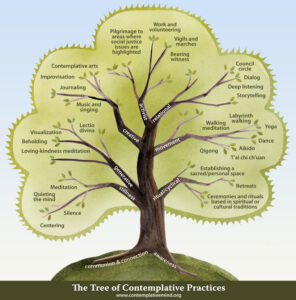By guest contributor, Laura Hill, Plant Biology
Today’s college student is seeking more from their higher education than simply gaining knowledge and skills. They are asking faculty to make the classroom experience more participatory, inclusive, and relevant. College students are searching for life purpose and meaning, according to an extensive survey of first-year students across the U.S conducted by Alexander Astin and colleagues. Students reported preoccupation with life’s big questions such as: “What are my most deeply felt values? Do I have a mission or purpose in my life? What kind of person do I want to become? What sort of world do I want to create?” (Astin et al., 2011).

This tree of contemplative practices is intended for illustrative purposes and is not a comprehensive list
UVM’s mission statement underscores our mission to graduate students with a “dedication to the global community” and an “enduring commitment to… ethical conduct,” both of which are touchstones to transformative education. How then are we creating space in the classroom to allow our students to explore their own personal agencies? What classroom activities are we creating to prepare students to cultivate their moral courage to engage in social dilemmas with clarity about their own values along with the capacity to actively listen to others with different values and opinions? (AAC&U, 2007). Economist Daniel Barbezat argues, “somehow we have lost our way in higher education and abandoned our mission to create lives of purpose and strong, ethical, and creative minds” (Barbezat and Bush, 2014).
What can faculty do to facilitate our students’ growing confidence, clarity, knowledge, skills, and values so that they graduate to be creative problem-solvers in our increasingly complicated global society? Without opportunities to inquire deeply, students will likely repeat the past, thus sacrificing the potential for a creative response. Many faculty across the globe are responding to this call with contemplative pedagogy. Contemplation is at the heart of all great scholarship, as it exemplifies profound concentration to a particular topic in a field of study (Barbezat and Bush, 2014).
The essence of contemplative pedagogy is to structure classroom activities to bring students into a first-person experience with the course material. Here, students experience the material in both an abstract, analytical manner (third-person) and deepen their understanding by contemplating their own, first-person experience. Ultimately, students gain empowerment in their learning, in themselves, and in the world.
Contemplative practices vary greatly (Figure 1) but all have an inward (first-person) focus that creates opportunities for greater connection and insight. Contemplative practices include structured activities that focus students to pay attention to the present experience. The critical aspect of all contemplative pedagogy is for students to discover their own internal reactions without having to adopt any specific ideology. Contemplative pedagogy aims to build students’ capacity, deepen understanding, generate compassion and resiliency, and inquire into their human nature (Barbezat and Bush, 2014).
UVM supports professional development in contemplative pedagogy, and there are rich avenues to explore the intersection of contemplation within the scholarship of teaching and learning (SoTL) model (Owen-Smith, 2018).
For more information about contemplative pedagogy, please consider the following upcoming opportunities:
- Attend the Contemplative Pedagogies talk as part of the New to the Faculty – Brown Bag Sessions hosted by the Office of the Provost, Tuesday, March 17 from 12-1:30PM in the Jost Foundation Room Davis Center 422
- Request an individual faculty consultation with Laura Hill, CTL Faculty Associate
- Apply to join the Fall 2020 cohort of the CTL Contemplative Faculty Learning Community. Applications will be solicited from all faculty in late Spring 2020. Email Laura Hill (lhill@uvm.edu) for more information.
References:
Association of American Colleges and Universities. (2007). College Learning for the New Global Century. A Report from the National Leadership Council for Liberal Education and America’s Promise. Accessed February 5, 2020 from: https://www.aacu.org/sites/default/files/files/LEAP/GlobalCentury_final.pdf (PDF)
Association of Contemplative Mind in Higher Education (ACMHE). The Tree of Contemplative Practices. Accessed February 5, 2020 from: http://www.contemplativemind.org/practices/tree
Astin, A.W., H.S. Astin, and J.A. Lindholm. (2011). Cultivating the Spirit: How College Can Enhance Students’ Inner Lives. San Francisco: Jossey-Bass.
Barbezat, D. P., & Bush, M. (2014). Contemplative practices in higher education: Powerful methods to transform teaching and learning. San Francisco: Jossey-Bass.
Owen-Smith, P. (2018). The Contemplative Mind in the Scholarship of Teaching and Learning. Indiana University Press.
